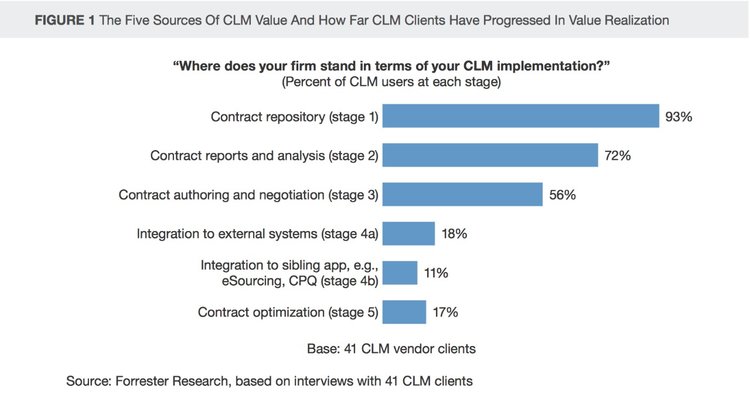You might think that everything about contracts has been automated. But in fact, that’s not true. Here’s a quick rundown on technology for contracts and why we still need humans to help create, analyze, and manage contracts.
Mainstream media regularly reports about robots and artificial intelligence replacing humans. Legal, compliance, and commercial contracting professionals hear that same message in their niches. And that’s no surprise given the recent rise of tech start-ups touting AI for contract analytics and contract management.
Beyond AI, we have the potential of Smart Contracts – self-executing contracts based on Blockchain technology. If (when?) Smart Contracts move beyond early pilots and very narrow applications, humans may not be displaced, but they certainly would be doing different work.
We don’t need AI or Blockchain, however, to automate contract management. Contract lifecycle management (CLM) has long promised smoother sailing and less administrative work. CLM is software that supports drafting, execution, storage, and managing rights and obligations. It’s been around for some 20 years.
In spite of all the tech options we have, it does not seem all that much about contracts has been automated, much less humans put out of work. In the real world, several problems stymie our progress. What are those problems?
First, many of the recent AI start-ups address relatively narrow aspects of contracting. Though many offer extremely useful tools to help with aspects of contracting, none offers the proverbial soup to nuts to solution. And companies find it time-consuming to evaluate a single product, much less multiple ones.
Second, Blockchain is intriguing but it’s very early days of smart contracting. The Blockchain pioneers have yet to align on a single platform, which limits reach. Moreover, creating smart contracts is not for the faint of heart. Many commentators have pointed out the challenges and risks of fully automating contracts. In the short term, smart contracts likely will be limited to very narrowly defined and simple transactions.
Third, even without AI and Blockchain hype, we face adoption and change management challenges. CLM is a relatively mature software category. Yet its penetration in the corporate world remains limited.
To gain the benefits of CLM, multiple stakeholders – legal, procurement, compliance, and business managers – must agree to use it. Moreover, individuals must change how they work. Those are both big challenges.
That explains why Forrester, in its The Forrester Wave™: Contract Life-Cycle Management, Q3 2016 report found limited realization of the value of CLM (see chart below). Keep in mind that this chart shows percentages for companies that have licensed CLM – and many have not.

With all these limitations, humans remain essential to all aspects of dealing with contracts. We need lawyers and commercial specialists to draft and review one-off contracts. They must approve variances from company contract playbooks. (Your company does have a playbook, doesn’t it?? Actually, many do not.)
We also need humans to help manage high-volume contracts, sometimes a team of people. Some multi-million-dollar contract management deals have been announced by alternative legal services providers. They marry tech with teams of humans.
Having a team helps at several stages of the contract process. When companies adopt CLM, they need to migrate a large volume of contracts into the system. Even after they have done so, an acquisition means loading another big corpus. Migrating (or loading) requires accurately extracting all of the key provisions of each contract.
AI products based on machine learning (ML) accelerate extracting contract provisions. But no ML is 100% accurate. Consequently, a person usually must quality check the ML extraction and manually capture provisions that the ML misses. Also, ML systems only handle contracts and provisions for which they were trained. Big contract collections may include items that fall outside of that scope. If so, humans must manually extract the provisions.
Teams also help capture contracts on a day-forward basis. (That is, ongoing contracts.) It’s a big challenge to get everyone in a company using an automated system to capture contracts. It can be culturally easier – and more practical – to let employees work how they want. Then, after whatever their legacy process is, a combination of automation and a team capture contract provisions. (That does not mean free reign to change provisions.)
Given the continued need for manual human work to support contract management, smart companies seek low-cost, low-risk, and high-efficiency options. The answer for many companies is to use an offshore service. Going offshore to countries like India has advantages beyond low labor cost. Business process outsourcing (BPO) and legal process outsourcing (LPO) companies in low-labor-cost countries have proven expertise in industrializing processes with rigorous controls, service level agreements, and metrics.
The march of technology to support contracting has been steady. Over time, the role of automation will grow. But the time frame is long. Today and for the foreseeable future, humans play an important role. Smart companies realize this. They combine the best of tech with lower-cost, high value offshore teams.
Cenza has extensive experience managing contracts and other legal documents. And we are trained in some of the leading machine learning products to extract contract provisions. We’d be happy to answer any questions you have about how we can help you automate your contracting process.
